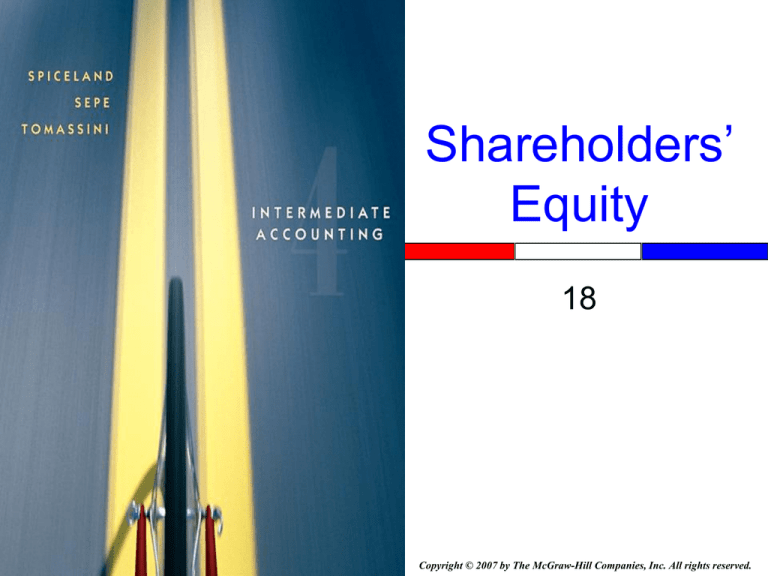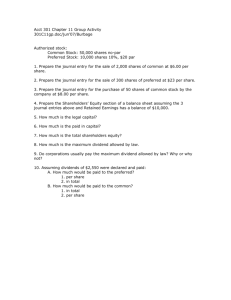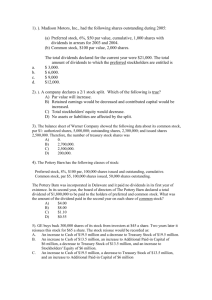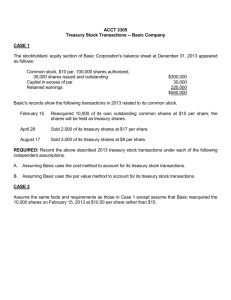
Shareholders’
Equity
Insert Book Cover
Picture
18
Copyright © 2007 by The McGraw-Hill Companies, Inc. All rights reserved.
18-2
Learning Objectives
Describe the components of shareholders’
equity and explain how they are reported in a
statement of shareholders’ equity.
18-3
The Nature of Shareholders’ Equity
Assets – Liabilities = Shareholders’ Equity
Net Assets
(Residual Interest)
18-4
Sources of Shareholders’ Equity
Amounts invested
by shareholders
Shareholders’ Equity
Paid-in Capital
Retained Earnings
Accumulated Other
Comprehensive Income
Amounts earned
by corporation
Other
gains and
losses not
included in
net income
18-5
The Corporate Organization
Advantages:
Ease of raising capital.
Ease of ownership transfer.
Limited liability.
Continuous existence.
Disadvantages:
Double taxation.
Government regulation.
18-6
Types of Corporations
Not-for-profit corporations include
hospitals, charities, and government
agencies such as FDIC.
Publicly-held corporations
whose shares are widely
owned by the general public.
Privately-held corporations
whose shares are owned by
only a few individuals.
18-7
Hybrid Organizations
S Corporation
Limited liability protection of a corporation.
Maximum number of owners.
Double
taxation
avoided.
Limited liability company
Limited liability protection of a corporation.
All owners may be involved in management
without losing limited liability protection.
No limit on number of owners.
Limited liability partnership
Owners are liable for their own actions but not
entirely liable for actions of other partners.
18-8
Formation of a Corporation
Nature and location
of business activities.
Number and classes
of shares authorized.
Composition of initial
board of directors.
18-9
Formation of a Corporation
Articles of incorporation
are filed with the state.
State issues a
corporate charter.
Shares of
stock issued.
Board of directors
appoint officers.
Board of directors
elected by
shareholders.
18-10
Fundamental Share Rights
Right
to vote.
Right to share
in profits when
dividends are
declared.
Preemptive
right to maintain
percentage
ownership.
Right to share
in distribution of
assets if company
is liquidated.
Authorized, Issued, and Outstanding
Capital Stock
Authorized
Shares
The maximum number
of shares of capital
stock that can be sold
to the public is called
the authorized number
of shares.
18-11
Authorized, Issued, and Outstanding
Capital Stock
Authorized
Shares
Issued
shares are
authorized
shares of
stock that
have been
sold.
Unissued
shares are
authorized
shares of
stock that
have never
been sold.
18-12
Authorized, Issued, and Outstanding
Capital Stock
Outstanding shares are
issued shares that are
owned by shareholders.
Authorized
Shares
Issued
Shares
18-13
Outstanding
Shares
Treasury
Shares
Unissued
Shares
Treasury shares are
issued shares that have
been reacquired by the
corporation.
Authorized, Issued, and Outstanding
Capital Stock
18-14
Outstanding shares are
issued shares that are
owned by stockholders.
Authorized
Shares
Outstanding
Shares
Retired
Shares
Unissued
Shares
Retired shares assume
the same status as
authorized but unissued
shares.
18-15
Capital Stock
Par value stock
Designated dollar
amount per share
stated in the
corporate charter.
Par value has no
relationship to market
value.
No-par stock
Dollar amount per
share not designated
in corporate charter.
Corporations can
assign a stated value
per share (treated as
if par value).
18-16
Capital Stock
Legal capital is . . .
The portion of shareholders’ equity that
must be contributed to the firm when stock
is issued.
The amount of capital, required by
state law, that must remain invested
in the business.
Refers to par value, stated value,
or full amount paid for no-par stock.
18-17
Types of Capital Stock
Common
Preferred
18-18
Common Stock
The basic voting stock of the corporation.
Ranks after preferred stock for dividend
and liquidation distribution.
Dividends determined by the board of
directors.
18-19
Preferred Stock
Generally does not
have voting rights.
Usually has a
par or stated value.
Dividend and
liquidation
preference over
common stock.
May be convertible,
callable, and/or
redeemable.
18-20
Preferred Stock Dividends
Are usually stated as a percentage of the
par or stated value.
May be cumulative or noncumulative.
May be partially participating, fully
participating, or nonparticipating.
Preferred Stock Dividends
Cumulative
Unpaid dividends must be paid in full before any
distributions to common stock.
Dividends in arrears are not liabilities, but the per
share and aggregate amounts must be
disclosed.
18-21
18-22
Learning Objectives
Describe comprehensive income and its
components.
18-23
Comprehensive Income
Comprehensive income includes losses and
gains that traditionally have
been excluded from net income.
Net holding
losses (gains)
on investments.
Postretirement plans:
Losses (gains)
Prior service cost.
Deferred losses
(gains) from
derivatives.
Losses (gains)
from foreign
currency
translations.
18-24
Comprehensive Income
Components of comprehensive income created during the reporting period:
($ in millions)
Net income
Other comprehensive income:
Net unrealized holding gains (losses) on investments (net of tax)† $ x
Losses (gains) on postretirement benefit plans (net of tax)‡
(x)
Prior service cost on postretirement benefit plans (net of tax)#
x
Deferred losses (gains) from derivatives (net of tax)§
Losses (gains) from foreign currency translation (net of tax)*
x
Comprehensive income
†
‡
#
§
*
$xxx
x
xx
$xxx
Changes in the market value of securities available-for-sale.
Increases (decreases) in the postretirement benefit obligation from changing assumptions as well as
plan assets earning less or more than expected (described in Chapter 17).
Cost of recalculating postretirement benefits in prior years after amending a plan. (described in Chapter
17).
When a derivative designated as a cash flow hedge is adjusted to fair value, the gain or loss is deferred
as a component of comprehensive income and included in earnings later, at the same time as earnings
are affected by the hedged transaction (described in the Derivatives Appendix to the text).
Gains or losses from changes in foreign currency exchange rates. The amount could be an addition to
or reduction in shareholders’ equity. (This item is discussed elsewhere in your accounting curriculum.)
18-25
Comprehensive Income
Comprehensive income is reported periodically as it is
created and also is reported as a cumulative amount.
There are 3 options for
reporting comprehensive
income created during the
reporting period.
As an additional
section of the
income
statement.
The accumulated amount of
comprehensive income is
reported as a separate item of
shareholders’ equity in the
balance sheet.
As part of the
statement of
shareholders’
equity.
As a separate
statement.
18-26
Learning Objectives
Record the issuance of shares when sold for
cash, for noncash consideration, and by share
purchase contract.
18-27
Issuing Stock for Cash
10,000 shares of $1 par value stock is issued for
$100,000 cash.
GENERAL JOURNAL
Page 1
Date
Description
Cash
Common Stock, par value
Paid-in Capital in Excess
of Par, Common Stock
PR
Debit
Credit
100,000
10,000
90,000
18-28
Issuing Stock for Cash
10,000 shares of no-par stock is issued for
$100,000 cash.
GENERAL JOURNAL
Page 1
Date
Description
Cash
Common Stock
PR
Debit
Credit
100,000
100,000
18-29
Issuing Stock for Cash
10,000 shares of no-par stock, with a stated value
of $1 is issued for $100,000 cash.
GENERAL JOURNAL
Page 1
Date
Description
Cash
PR
Debit
Credit
100,000
Common Stock, stated value
10,000
Paid-in Capital in Excess of
Stated Value, Common Stock
90,000
18-30
Issuing Stock for Noncash Assets
Apply the general valuation principle by using
fair value of stock given up or fair value of
asset received, whichever is more clearly
evident.
If market values cannot be determined, use
appraised values.
More Than One Security Issued
for a Single Price
Allocate
18-31
the lump-sum received based on
the relative fair values of the two
securities.
If only one fair value is known, allocate a
portion of the lump-sum received based on
that fair value and allocate the remainder
to the other security.
More Than One Security Issued
for a Single Price
Toys, Inc. issued 5,000 shares of common
stock, $10 par value and 3,000 shares of
preferred stock, $5 par value for $450,000.
The market values of the common stock
and preferred stock were $55 and $75,
respectively.
Calculate the additional paid-in
capital for each class of stock.
18-32
More Than One Security Issued
for a Single Price
Common Stock
Preferred Stock
Total
Market*
$275,000
225,000
$500,000
18-33
%
Allocation** Par^
Excess^^
55% $ 247,500 $ 50,000 $ 197,500
45% 202,500
15,000
187,500
100% $ 450,000 $ 65,000 $ 385,000
* Market Value:
Common: $55 × 5,000 shares
Preferred: $75 × 3,000 shares
^ Par Value:
Common: $10 × 5,000 shares
Preferred: $5 × 3,000 shares
**Allocation:
Common: $450,000 × 55%
Preferred: $450,000 × 45%
^^Excess:
Common: $247,500 - $50,000 par
Preferred: $202,500 - $15,000 par
Record the journal entry for issuing the stock.
More Than One Security Issued
for a Single Price
18-34
GENERAL JOURNAL
Page 1
Date
Description
Cash
Common Stock, par $10
Preferred Stock, par $5
Additional paid-in capital,
Common Stock
Additional paid-in capital
Preferred Stock
To record issue of stock for cash
PR
Debit
Credit
450,000
50,000
15,000
197,500
187,500
18-35
Share Issue Costs
Registration fees
Underwriter commissions
Printing and clerical costs
Legal and accounting fees
Promotional costs
Share issue costs reduce net proceeds
from selling shares, resulting in a lower
amount of additional paid-in capital.
18-36
Share Purchase Contracts
An agreement between a corporation and
a subscriber whereby shares are sold
in exchange for a promissory note.
Dow Industrial sold 100,000 shares of its
$1 par value stock for $10 using a share
purchase contract. Forty percent of the sale
price was collected at sale and sixty
percent will be received in six months.
Prepare the journal entry for this transaction.
18-37
Share Purchase Contracts
GENERAL JOURNAL
Page 8
Date
Description
PR
Debit
Cash
400,000
Receivable from share purchase contract
600,000
Credit
Common stock
100,000
Additional paid-in capital
900,000
The receivable is not an asset.
It is reported as reduction in paid-in capital.
18-38
Let’s turn our
attention to
reacquiring
shares.
18-39
Share Buybacks
A corporation might reacquire shares of its
stock to . . .
Support the market price.
Increase earnings per share.
Distribute in stock option plans.
Issue as a stock dividend.
Use in mergers and acquisitions.
Thwart takeover attempts.
18-40
Share Buybacks
I can account for
the reacquired shares
by retiring them or by
holding them as
treasury shares.
18-41
Learning Objectives
Describe what occurs when shares are retired
and how retirement is recorded.
18-42
Accounting for Retired Shares
When shares are formally retired, we reduce
the same capital accounts that were
increased when the shares were issued –
common or preferred stock, and additional
paid-in capital.
18-43
Accounting for Retired Shares
Price paid is less than issue price.
5,000 shares of $2 par value stock that were issued
for $20 per share are reacquired for $17 per share.
GENERAL JOURNAL
Page 1
Date
Description
Common Stock
Paid-in Capital in Excess of Par
Paid-in Capital - Share Repurchase
Cash
PR
Debit
Credit
10,000
90,000
15,000
85,000
18-44
Accounting for Retired Shares
Price paid is more than issue price.
5,000 shares of $2 par value stock that were issued
for $20 per share are reacquired for $25 per share.
Reduce Retained Earnings if the
GENERAL JOURNAL
Paid-in Capital – Share Repurchase
Page 1
account balance is insufficient.
Date
Description
Common Stock
Paid-in Capital in Excess of Par
Paid-in Capital - Share Repurchase
Cash
PR
Debit
Credit
10,000
90,000
25,000
125,000
18-45
Learning Objectives
Distinguish between accounting for retired
shares and for treasury shares.
18-46
Treasury Stock
Usually does not have:
Voting rights.
Dividend rights.
Preemptive rights.
Liquidation rights.
Reduces both assets and
shareholders’ equity.
18-47
Accounting for Treasury Stock
Acquisition of Treasury Stock
Recorded at cost to acquire.
Resale of Treasury Stock
Treasury Stock credited for cost.
Difference between cost and
issuance price is (generally)
recorded in paid-in capital –
share repurchase.
18-48
Accounting for Treasury Stock
On 5/1/05, Photos-in-a-Second reacquired 3,000
shares of its common stock at $55 per share. On
12/3/06, Photos-in-a-Second reissued 1,000
shares of the stock at $75 per share. Which of
the following would be included in the 12/3 entry?
a.
b.
c.
d.
Credit Cash for $165,000.
Debit Treasury Stock for $75,000.
Credit Treasury Stock for $55,000.
Credit Cash for $75,000.
18-49
Accounting for Treasury Stock
On 5/1/05, Photos-in-a-Second reacquired 3,000
shares of its common stock at $55 per share. On
12/3/06, Photos-in-a-Second reissued 1,000
shares of the stock at $75 per share. Which of
the following would be included in the 12/3 entry?
a.
b.
c.
d.
Credit Cash for $165,000.
Debit Treasury Stock for $75,000.
Credit Treasury Stock for $55,000. Solution
Credit Cash for $75,000.
18-50
Accounting for Treasury Stock
GENERAL JOURNAL
Date
May 1, 2005
Dec. 3, 2006
Description
PR
Debit
Treasury Stock
Cash
To record purchase of treasury stock.
165,000
Cash
Treasury Stock
Paid-in Capital-Share Repurchase
To record sale of treasury stock.
75,000
Page 1
Credit
165,000
55,000
20,000
18-51
Reporting Treasury Stock
Reported in Shareholders’ Equity.
Unallocated reduction
of total Shareholders’
Equity.
18-52
Learning Objectives
Describe retained earnings and distinguish
it from paid-in-capital.
18-53
Retained Earnings
Represents the undistributed earnings of the
company since its inception.
Balance January 1, 2006
Net income
Cash dividends
Balance December 31, 2006
$ 500,000
25,000
(10,000)
$ 515,000
18-54
Retained Earnings
The
statement of retained earnings may
also contain the correction of an
accounting error that occurred in the
financial statements of a prior period,
called a prior period adjustment.
Any restrictions on retained earnings
must be disclosed in the notes to the
financial statements.
Example: Shareholders’ Equity
Section of a Balance Sheet
Shareholders' Equity
Captial Stock:
Common Stock - $10 par value; 60,000 shares
authorized; 20,000 shares issued and
outstanding
Preferred Stock - $100 par value; 1,000 shares
authorized; 400 shares issued and
outstanding
Additional paid-in capital
From issuance of common stock
From issuance of preferred stock
Total paid-in capital
Retained earnings
Total stockholders' equity
18-55
$ 200,000
40,000
300,000
10,000
550,000
121,500
$ 671,500
18-56
Learning Objectives
Explain the basis of corporate dividends,
including the similarities and differences
between cash and property dividends.
18-57
Cash Dividends
Dividends must be
declared by the board
of directors before
they can be paid.
A corporation is not
legally required to
pay dividends.
Cash dividends
require sufficient cash
and retained earnings
to cover the dividend.
When a dividend is
declared, a liability
is created.
18-58
Dividend Dates
Declaration date
Board of directors declares
the dividend.
Record a liability.
GENERAL JOURNAL
Date
Description
Retained Earnings
Dividends Payable
Post.
Ref.
Page 12
Debit
Credit
XXX
XXX
18-59
Dividend Dates
Ex-dividend date
The first day the shares trade without the
right to receive the declared dividend.
(No entry)
July
X
18-60
Dividend Dates
Date of record
Stockholders holding shares on this date
will receive the dividend. (No entry)
July
X
X
18-61
Dividend Dates
Date of payment
Record the payment of the
dividend to stockholders.
GENERAL JOURNAL
Date
Description
Dividends Payable
Cash
Post.
Ref.
Page 12
Debit
Credit
XXX
XXX
18-62
Property Dividends
Distributions
of non-
cash assets.
Record at fair value of
non-cash asset.
Recognize gain or
loss for difference
between book value
and fair value.
18-63
Learning Objectives
Explain stock dividends and stock splits
and how they are accounted for.
18-64
Stock Dividends
Distribution of additional shares of stock to
shareholders.
No change in total
shareholders’ equity.
All shareholders
receive the same
percentage increase
in shares.
18-65
Stock Dividends
Reasons for stock dividends:
To preserve cash.
To decrease market price
of stock.
To reduce existing balance
in retained earnings.
18-66
Stock Dividends
Small
Large
Stock dividend < 25%
Stock dividend > 25%
Record at current
market value
of stock.
Record at par or
stated value
of stock.
18-67
Stock Dividends
CarCo declares and distributes a 20%
stock dividend on 5 million common
shares. Par value is $1 and market value
is $20. Prepare the required journal entry.
GENERAL JOURNAL
Date
Description
Post.
Ref.
Page 21
Debit
Credit
18-68
Stock Dividends
CarCo declares and distributes a 20%
stock dividend on 5 million common
shares. Par value is $1 and market value
is $20. Prepare the required journal entry.
GENERAL JOURNAL
Date
Description
Retained Earnings
Common Stock
Post.
Ref.
Page 21
Debit
Credit
20,000,000
1,000,000
Paid-in Capital in
Excess of Par
19,000,000
18-69
Stock Splits
Decrease
par value of
stock.
Increase number of
outstanding shares.
No change in total
stockholders’ equity.
Does not require a
journal entry.
Ice Cream Parlor
Banana Splits
On Sale Now
18-70
Accounting for Stock Splits
A corporation had 5,000 shares of
$1 par value common stock outstanding
before a 2–for–1 stock split.
Before
Split
Common Stock Shares
5,000
Par Value per Share
$ 1.00
Total Par Value
$ 5,000
After
Split
18-71
Accounting for Stock Splits
A corporation had 5,000 shares of
$1 par value common stock outstanding
before a 2–for–1 stock split.
Before
Split
Common Stock Shares
Par Value per Share
Total Par Value
5,000
$ 1.00
$ 5,000
After
Split
10,000
Increase
$ 0.50 Decrease
$ 5,000
No
Change
Stock Splits Effected in the
Form of Large Stock Dividends
18-72
Matrix, Inc. declares and distributes a 2-for-1 stock
split effected in the form of a 100% stock dividend.
The company has 1,000,000, $1 par value common
stock outstanding. The stock is trading in the open
market for $14 per share. The per share par value
of the shares is not to be changed.
GENERAL JOURNAL
Date
Description
Paid-in Capital in Excess of Par
Common Stock
Post.
Ref.
Page 21
Debit
Credit
1,000,000
1,000,000
Stock Splits Effected in the
Form of Large Stock Dividends
18-73
Matrix, Inc. declares and distributes a 2-for-1 stock
split effected in the form of a 100% stock dividend.
The company has 1,000,000, $1 par value common
stock outstanding. The stock is trading in the open
market for $14 per share. The per share par value of
the shares is not to be changed and the company will
capitalize retained earnings.
GENERAL JOURNAL
Date
Description
Retained Earnings
Common Stock
Post.
Ref.
Page 21
Debit
Credit
1,000,000
1,000,000
18-74
Quasi
Reorganizations
Appendix 18
18-75
Quasi Reorganizations
Purpose
To allow a company undergoing financial
difficulty, but with favorable future
prospects, to get a fresh start by writing
down inflated assets and eliminating an
accumulated balance in retained earnings.
18-76
Quasi Reorganizations
Procedures
The firm’s assets and liabilities are revalued to
reflect market values, with corresponding debits
and credits to retained earnings.
The debit balance in retained earnings is
eliminated first against additional paid in capital,
and then, if necessary, against common stock.
Retained earnings is dated to indicate when the
new accumulation of earnings began.
18-77
Quasi Reorganizations
Emerson-Walsch Corporation has incurred
losses for several years. The board
of directors voted to implement a
quasi reorganization, subject
to shareholder approval.
The balance sheet prior to
restatement, in millions, follows :
18-78
Quasi Reorganizations
Cash
Receivables
Inventory
Property, plant, and equipment (net)
Total assets
Liabilities
Common stock (800 million shares @$1)
Additional paid-in capital
Retained earnings (deficit)
Total liabilities and equity
(millions)
$
75
200
375
400
$
1,050
$
$
400
800
150
(300)
1,050
Fair value of the inventory is $300,000,000 and fair value
of the property, plant, and equipment is $225,000,000.
Let’s prepare the journal entries
necessary for the quasi reorganization.
18-79
Quasi Reorganizations
To revalue assets.
GENERAL JOURNAL
Date
Description
Retained Earnings
Inventory
Property, plant, & equipment
Page 43
Post.
Ref.
Debit
Credit
250
75
175
18-80
Quasi Reorganizations
To eliminate the deficit in retained earnings
GENERAL JOURNAL
Date
Description
Page 43
Post.
Ref.
Debit
Additional paid-in capital
150
Common stock
400
Retained earnings
Credit
550
$300 + $250
Now, let’s prepare the balance sheet
immediately after restatement.
18-81
Quasi Reorganizations
Cash
Receivables
Inventory
Property, plant, and equipment (net)
Total assets
$
Liabilities
Common stock (800 million shares @$.50)
Additional paid-in capital
Retained earnings
Total liabilities and equity
$
$
$
75
200
300
225
800
400
400
0
0
800
18-82
End of Chapter 18








